Guest post by Katrina & Clayton
Rosemary, with its fragrant aroma and culinary versatility, is an evergreen herb that adds flavour to dishes and charm to gardens and is loved by bees and butterflies alike. Despite Scotland’s cooler climate, with proper care, this Mediterranean native can flourish and grow into a wonderful addition to your garden.
Rosemary is primarily grown for its leaves, which are used fresh or dried to add to dishes. The leaves can be stripped from the stems and chopped into fine pieces to add flavour to any dishes pastry or bread. Rosemary flowers, which appear in spring and summer, are also edible and make a lovely garnish with a milder flavour than the leaves.
Growing Rosemary in Scotland
Rosemary (Salvia rosmarinus) prefers milder conditions but can adapt to the cooler, sometimes challenging Scottish climate. It thrives when given maximum sunlight and protection from harsh winter winds. Planting in a favourable spot and ensuring good soil conditions are key to successfully growing rosemary in Scotland.
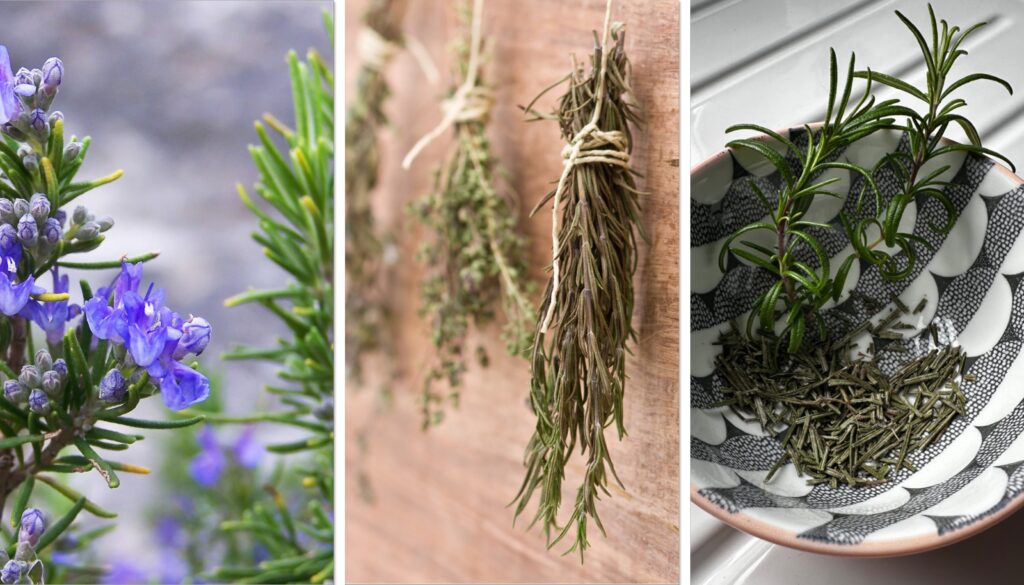
Rosemary flowers, drying rosemary, fresh and dried rosemary
Planting: Starting from Seed
Timing: Rosemary seeds can be sown indoors in late winter to early spring. They require patience and care, as germination can be slow and uneven and require a constant temperature of 21ºC to grow.
Seed Starting: Use shallow trays filled with a seed starting mix or like we do, use Caledonian Topsoil on its own. Sprinkle rosemary seeds over the soil and cover them lightly with a thin layer of the same mix. Keep the soil moist but not waterlogged.
Transplanting: Once seedlings have grown large enough to handle and there’s no risk of frost, gradually acclimate them to outdoor conditions before transplanting into the garden.
Pruning Rosemary
A much easier and more effective way to create more rosemary plants is by propagation, you can do this when pruning.
Pruning: regular pruning not only keeps rosemary plants healthy and well-shaped but also encourages bushy growth. Trim back annually in early spring to prevent woodiness at the base. You can use these prunings to propagate or hang up to dry to use in your dishes.
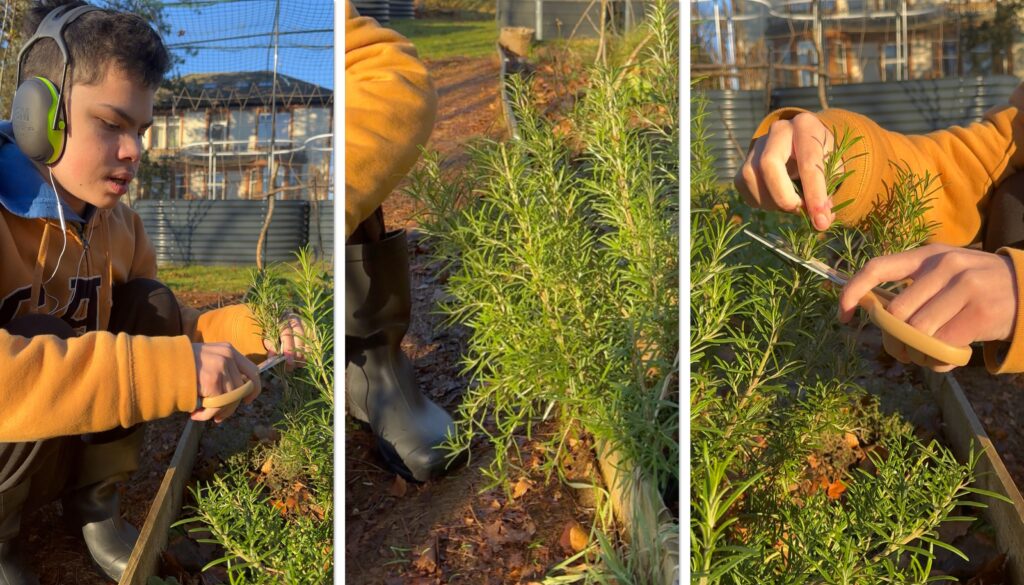
Clayton pruning our rosemary plant taking 10-15cm off each stem to propagate from
Propagating Rosemary
Rosemary is most commonly propagated by cuttings, rather than grown from seed. Taking softwood stem-tip cuttings from the new growth is suitable for many perennial herbs such as rosemary, lemon balm, mint, oregon, sage and thyme.
Cuttings: Take 10-15 cm cuttings from new, soft growth in late spring or early summer or use your prunings.
Remove: First remove the lower leaves that would be under soil level in your pot, dip the cut end in water, then into a natural rooting hormone powder, (this works by imitating auxina, a natural plant hormone that encourages plant development) and then pop into the edge of a pot.
Keep the cuttings moist and covered with a plastic bag to maintain humidity until roots develop.
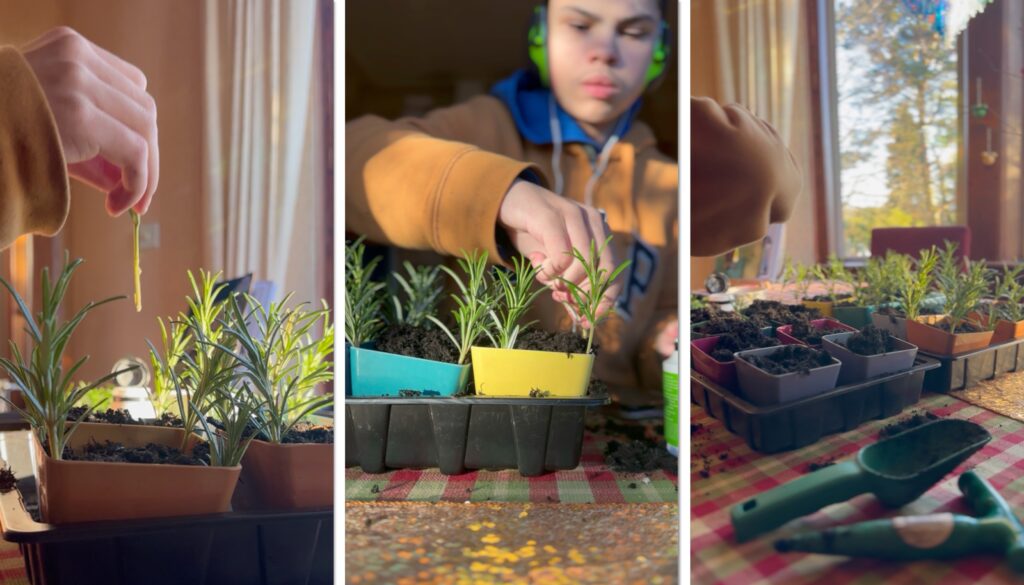
Clayton showing how to propagate.
Bottom of the stem leaves removed, putting them in each corner of the pots, propagating a few trays
Caring for Rosemary
Watering: Water rosemary plants deeply but infrequently, allowing the soil to dry out between waterings. Overwatering or poor drainage can lead to root rot.
Feeding: An annual spring application of a balanced, slow-release fertiliser is sufficient. Overfeeding can diminish its flavour and scent. We’ve added Caledonian Green Goodness around the base of our this Spring for slow release.
Winter Care: In colder parts of Scotland, it is recommended to protect rosemary in winter by covering the plant with fleece or moving potted plants indoors. Ensuring plants in the ground are in well-draining soil to avoid waterlogging, which can be fatal in winter temperatures.
Companion Planting with Rosemary
Rosemary pairs well with many plants, offering mutual benefits:
Vegetables: Plant near carrots, beans, and cabbage to help repel pests like carrot flies and bean beetles.
Herbs: Sage, thyme, and lavender share similar growing requirements and can be planted together with rosemary.
Flowers: Plant alongside marigolds to enhance garden aesthetics and deter pests.
Avoid planting rosemary near basil, which prefers more moisture and can compete with rosemary’s growth.
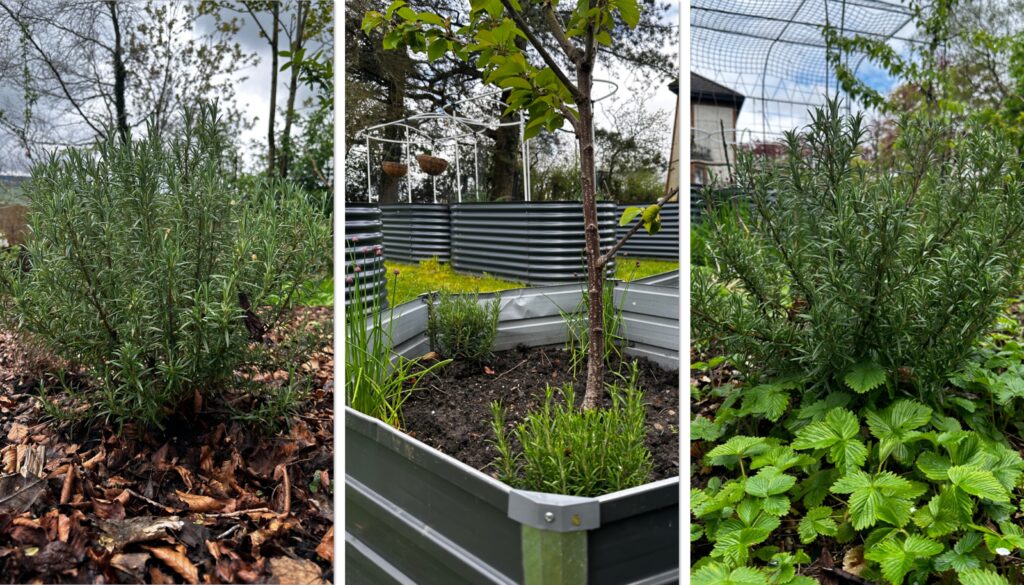
Rosemary around our garden:
In the food forest, in raised beds, surrounded by strawberry ground cover
Optimal Soil for Rosemary
Rosemary thrives in well-drained, sandy or loamy soil with a pH between 6.0 and 7.0. If your garden soil is heavy and clayey, consider growing rosemary in raised beds or containers for better drainage. Adding a yearly slow release mulch/feed is beneficial to thriving rosemary.
Rosemary is a resilient and aromatic herb that, with the right care, can be a fantastic addition to a Scottish garden. If you are looking at more rosemary in your garden, it is the ideal time to think about propagating some rosemary now.
Katrina & Clayton

Katrina & Clayton live with their family in East Ayrshire in Scotland and share their daily life in the garden on instagram @buildingfoodforest_scotland. They practice permaculture principles, reducing & repurposing waste whenever they can. Katrina shows how home educating in nature has helped Clayton thrive.
Clayton Completed The Grow and Learn Course with the Royal Caledonian Horticultural Society in 2022. This year he will be completing Level 2 Nurture Course. Clayton is 16, Autistic, Non Verbal & has been Home Educated for the last 6yrs. Both Katrina and husband Peter have studied the Permaculture Design Course PDC and PDC Pro over the last 5yrs, developing their garden from grass to an ongoing food forest.
They have featured on BBC Beechgrove Gardens, Gardeners World Magazine and write for Scotland Grows Magazine. Katrina has a series of children’s story books out following the life of Clayton in the garden. Available at Amazon.
See more and follow Katrina & Clayton at the links below:
-
 Builder’s Bag Green Goodness£52.00 inc VATRated 4.90 out of 5 based on 199 customer ratings
Builder’s Bag Green Goodness£52.00 inc VATRated 4.90 out of 5 based on 199 customer ratings -
 Builder’s Bag Topsoil£68.00 inc VATRated 4.92 out of 5 based on 165 customer ratings
Builder’s Bag Topsoil£68.00 inc VATRated 4.92 out of 5 based on 165 customer ratings -
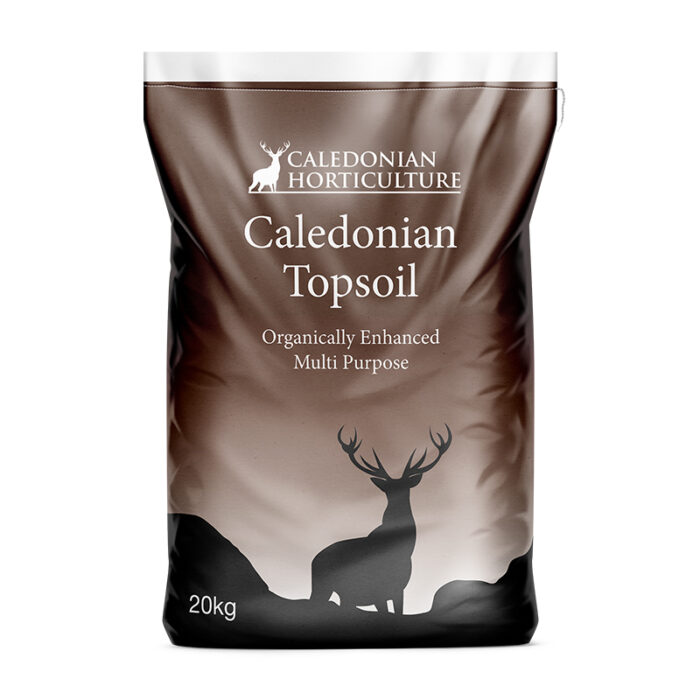 20kg Caledonian Topsoil£3.50 – £4.50Price range: £3.50 through £4.50 inc VATRated 4.97 out of 5 based on 34 customer ratings
20kg Caledonian Topsoil£3.50 – £4.50Price range: £3.50 through £4.50 inc VATRated 4.97 out of 5 based on 34 customer ratings



